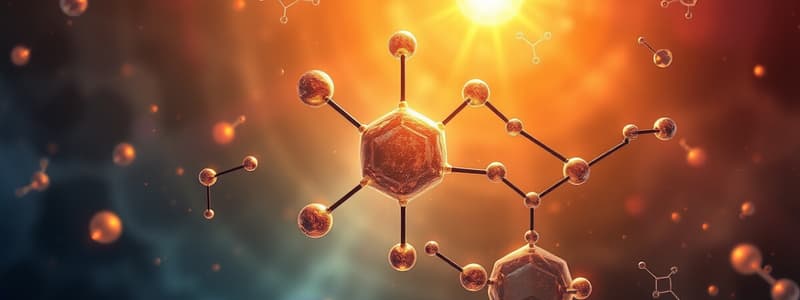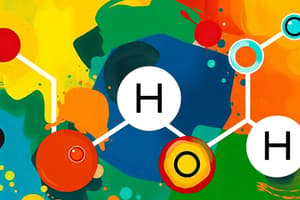Podcast
Questions and Answers
What characterizes alkenes among types of hydrocarbons?
What characterizes alkenes among types of hydrocarbons?
- They are composed only of carbon and nitrogen.
- They contain only single bonds.
- They must contain three carbon atoms.
- They have at least one double bond. (correct)
Which functional group is characteristic of alcohols?
Which functional group is characteristic of alcohols?
- Carboxyl (-COOH)
- Hydroxyl (-OH) (correct)
- Carbonyl (-C=O)
- Amino (-NH2)
What type of isomerism involves structural differences in the connectivity of atoms?
What type of isomerism involves structural differences in the connectivity of atoms?
- Stereoisomerism
- Structural isomerism (correct)
- Optical isomerism
- Geometric isomerism
Which reaction type involves the addition of atoms across a double or triple bond?
Which reaction type involves the addition of atoms across a double or triple bond?
Which mechanism is involved in a nucleophilic substitution reaction?
Which mechanism is involved in a nucleophilic substitution reaction?
Which class of organic compounds contains at least one carbonyl group?
Which class of organic compounds contains at least one carbonyl group?
In IUPAC nomenclature, which step is vital for identifying the carbon chain?
In IUPAC nomenclature, which step is vital for identifying the carbon chain?
What type of hydrocarbons contains aromatic rings?
What type of hydrocarbons contains aromatic rings?
Which statement correctly describes diffusion?
Which statement correctly describes diffusion?
What distinction does dialysis have within the context of diffusion?
What distinction does dialysis have within the context of diffusion?
Which condition must be satisfied for osmosis to occur?
Which condition must be satisfied for osmosis to occur?
How does osmotic pressure change during the process of osmosis?
How does osmotic pressure change during the process of osmosis?
What is the main difference between facilitated diffusion and regular diffusion?
What is the main difference between facilitated diffusion and regular diffusion?
Flashcards are hidden until you start studying
Study Notes
Organic Chemistry Overview
- Definition: Study of carbon-containing compounds and their properties, structures, reactions, and synthesis.
- Importance: Essential in pharmaceuticals, petrochemicals, food chemistry, and biochemistry.
Key Concepts
-
Hydrocarbons:
- Compounds composed of hydrogen and carbon.
- Types:
- Aliphatic: Linear or branched (alkanes, alkenes, alkynes).
- Aromatic: Contain one or more benzene rings.
-
Functional Groups:
- Specific groups of atoms that impart characteristic properties and reactions.
- Common groups:
- Hydroxyl (-OH): Alcohols.
- Carbonyl (C=O): Aldehydes and ketones.
- Carboxyl (-COOH): Carboxylic acids.
- Amino (-NH2): Amines.
- Ester (-COOR): Esters.
-
Isomerism:
- Compounds with the same molecular formula but different structures.
- Types:
- Structural isomers: Different connectivity.
- Stereoisomers: Same connectivity but different spatial arrangements (cis-trans, enantiomers).
-
Reactions:
- Types of reactions in organic chemistry:
- Addition: Atoms add to a double or triple bond.
- Elimination: Removal of atoms to form double or triple bonds.
- Substitution: Exchange of one functional group for another.
- Rearrangement: Reorganization of the carbon skeleton.
- Types of reactions in organic chemistry:
-
Mechanisms:
- Detailed descriptions of the steps involved in organic reactions.
- Types include:
- Nucleophilic substitution (SN1 and SN2).
- Electrophilic addition.
- Radical reactions.
Important Classes of Organic Compounds
- Alkanes: Saturated hydrocarbons (single bonds).
- Alkenes: Unsaturated hydrocarbons (at least one double bond).
- Alkynes: Unsaturated hydrocarbons (at least one triple bond).
- Aromatic Compounds: Contain benzene or related structures.
- Alcohols: Organic compounds with one or more hydroxyl groups.
- Ethers: Compounds with an oxygen atom connected to two alkyl or aryl groups.
- Aldehydes and Ketones: Contain carbonyl groups, differing in structure.
- Carboxylic Acids and Derivatives: Contain carboxyl groups and can form esters, amides, etc.
Nomenclature
- IUPAC Naming: Systematic naming based on structure and functional groups.
- Identify longest carbon chain.
- Number the chain to give the lowest locants to functional groups.
- Use prefixes and suffixes to denote substituents and functional groups.
Spectroscopy and Analysis
- Techniques for identifying organic compounds:
- NMR (Nuclear Magnetic Resonance): Determines structure based on magnetic properties of nuclei.
- IR (Infrared Spectroscopy): Identifies functional groups by measuring molecular vibrations.
- MS (Mass Spectrometry): Analyzes molecular weight and structure by ionizing chemical species.
Applications
- Pharmaceuticals: Drug design and synthesis.
- Materials Science: Development of polymers and new materials.
- Biochemistry: Study of biomolecules and metabolic pathways.
Organic Chemistry Overview
- Organic chemistry focuses on carbon-containing compounds, encompassing their properties, structures, reactions, and synthesis.
- Vital in sectors like pharmaceuticals, petrochemicals, food chemistry, and biochemistry.
Key Concepts
- Hydrocarbons: Composed of hydrogen and carbon; can be classified into aliphatic (alkanes, alkenes, alkynes) and aromatic (containing benzene rings).
- Functional Groups: Distinct atom groups that determine the behavior of molecules; key functional groups include:
- Hydroxyl (-OH) for alcohols
- Carbonyl (C=O) for aldehydes and ketones
- Carboxyl (-COOH) for carboxylic acids
- Amino (-NH2) for amines
- Ester (-COOR) for esters
- Isomerism: Describes compounds with the same molecular formula but different structures, categorized into:
- Structural isomers with different atom connections
- Stereoisomers that differ in spatial arrangements (like cis-trans and enantiomers)
- Reactions in Organic Chemistry: Include:
- Addition: Atoms added to double/triple bonds
- Elimination: Removal of atoms forms double/triple bonds
- Substitution: Replacement of a functional group
- Rearrangement: Changes in carbon skeleton organization
- Reactions Mechanisms: Describe stepwise processes in reactions; includes:
- Nucleophilic substitution (SN1/SN2)
- Electrophilic addition
- Radical reactions
Important Classes of Organic Compounds
- Alkanes: Saturated hydrocarbons characterized by single bonds.
- Alkenes: Unsaturated hydrocarbons that contain at least one double bond.
- Alkynes: Unsaturated hydrocarbons that contain at least one triple bond.
- Aromatic Compounds: Compounds that contain benzene or similar structures.
- Alcohols: Organic compounds featuring one or more hydroxyl (-OH) groups.
- Ethers: Composed of an oxygen atom connected to two alkyl or aryl groups.
- Aldehydes and Ketones: Both contain carbonyl groups but differ in their structure.
- Carboxylic Acids and Derivatives: Compounds with carboxyl groups, including esters and amides.
Nomenclature
- IUPAC Naming: A systematic approach based on molecular structure and functional groups; involves:
- Identifying the longest carbon chain
- Numbering the chain to assign lowest locants to functional groups
- Utilizing prefixes and suffixes to represent substituents and functional groups
Spectroscopy and Analysis
- Techniques used for identifying organic compounds include:
- NMR (Nuclear Magnetic Resonance): Reveals structure based on the magnetic properties of nuclei.
- IR (Infrared Spectroscopy): Identifies functional groups through molecular vibrations.
- MS (Mass Spectrometry): Determines molecular weight and structure via ionization of chemical species.
Applications
- Pharmaceuticals: Incorporates drug design and synthesis processes.
- Materials Science: Involves the creation of polymers and innovative substances.
- Biochemistry: Focuses on analyzing biomolecules and metabolic pathways.
Diffusion
- Random scattering of substances occurs until equilibrium is achieved.
- Can transpire through living membranes with particles moving in both directions; diffusion always occurs down the concentration gradient.
- Dialysis is a specific type of diffusion for crystalloids, such as salts and sugars, which diffuse down the concentration gradient.
- Facilitated diffusion involves molecules in a membrane that assist substances in passing through more easily.
Osmosis
- Defined as the diffusion of water through a selectively permeable (semi) membrane.
- A concentration gradient of at least one substance must be maintained across the membrane for osmosis to occur.
- Water moves down its concentration gradient, striving for equilibrium between both sides of the membrane.
- As water volume increases on one side of the membrane, osmotic pressure also rises.
- Three types of solutions relate to osmosis: isotonic (equal concentration), hypertonic (higher concentration outside), and hypotonic (lower concentration outside).
Studying That Suits You
Use AI to generate personalized quizzes and flashcards to suit your learning preferences.




